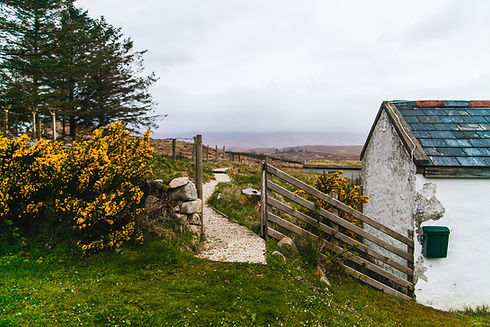
Clann History
Clann Ó Dochartaigh is an ancient Donegal family descended from the legendary kings and princes of Ireland. Our Irish Ó Dochartaigh ancestors were a tight knit community who farmed and fished, fiddled and danced, prayed and fought, and lived and died—together—for generations upon generations across the centuries in their cottages and castles nestled amongst the fertile glens and rugged mountains of their Donegal homeland. An understanding of the Ó Dochartaigh Clann of yore is truly an understanding our own ancestors who were an integral part of that proud group descended from the legendary princes and kings of Ireland.
Ancient Legend
Ireland's rich history is steeped in oral tradition, with folk legends and mythology continuing to influence Irish culture today. According to legend, the Irish people descended from the Milesians, who migrated from the Middle East through Spain to Ireland. The Milesians defeated the Tuatha Dé Danann, supernatural inhabitants of Ireland, in a battle for control of their promised island. Lugh, a skilled warrior and craftsman, played a key role in these battles. These stories explain the origins of the Irish people, passed down through generations as part of the country's rich cultural heritage. Notable kings, such as Conn of the Hundred Battles and Niall of the Nine Hostages, played important roles in ancient Ireland's development. Recent developements in genetics show there may have been some truths at the core of these legends.
The Formation of a Family
The Síl Lugdach were a prominent Irish family whose lineage may extend back to Conal Gulban, the first Irish nobleman to be baptized by St. Patrick. According to genealogies, Conal's descendant Lughaid was the progenitor of the Síl Lugdach tribe, the most prominent branches of which are the O'Dochartaighs and the O'Donnells. The family began expanding throughout Donegal during around the 8th-century. During this time, a warrior was given the name Dochartach, meaning hurtful, likely in honor of valiant feats in battle. His descendants assumed the surname O'Dochartaigh. The O'Dochartaigh Clann grew, becoming a powerful family who ruled from the the Dunwiley ringfort near Stranorlar. Two O'Dochartaigh chieftains later rose to become Kings of all Donegal.
The Golden Age: Inishowen
The golden age of the O'Dochartaigh power was from the 14th through the 16th centuries. As the family grew, they exploited a power vacuum, and moved north to assume the Lordship of Inishowen. They maintained a ring of defensive castles, including the family seat at ancient Elagh, and other notable fortresses like O'Doherty's Keep, Burt, Carrickabraghy, and Inch Castles. The family fished and communally farmed and pastured their cattle on the fertile penninsula. The family grew into seven branches that ruled different parts of the Inishowen. The O'Dochartaighs remained a strong military presence often working with or against neighboring clanns as it was advantageous to protect their territory.
The O'Doherty Rebellion
During the English conquest of Ireland in the 16th century, the Northern Uí Néill, among whom were the Ó Dochartaigh, were the last to submit. After years of resistance, they submitted to the English, but continued to prepare for rebellion. Cahir Ó Dogherty, the teenage chieftain of the Ó Dochartaigh Clann, allied with the English governor of Derry, but was later provoked into rebellion by a new governor who wanted to take the family's lands. Cahir and his men burned down Derry and fought bravely against the English, but Cahir was eventually captured, executed, and displayed on a pike. He was the last remaning Gaelic chieftain of Ireland.
The Modern Era
The fall of the ancient Gaelic power in Ireland led to the Ulster Plantation and the confiscation of O'Dochartaigh lands, creating political and religious conflict that still affects the area today. Sir Cahir O'Dogherty's sister returned from Spain in 1641 to plan another rebellion, but was unable to restore Irish rule. The oppresive Penal Laws were instituted following this. During the mid-19th century, the Great Irish Hunger caused by the potato famine send many Dohertys to America and other nations. More recently, the "Troubles", a period of political and sectarian violence occurred near Derry. Despite the centuries that have passed, Donegal's stunning beauty and the revival of Gaelic culture in many areas are noteworthy.





